PIONEER DDJ-REV1

INSTALLATION
Firmware & Drivers
Firmware: At the time this manual was written there are no firmware updates available for Pioneer DDJ-REV1. However always check Pioneer Dj website for any firmware updates.
Drivers: No drivers are required for the Pioneer DDJ-REV1 to operate. The device is a USB class compliant and your Operating System will auto-install the necessary drivers when connected with a USB cable.
(in case you have not done already)
Once VirtualDJ is launched, a Login Window will appear. Please login with your preferred method from the ones provided.
A Pro Infinity, a Pro Subscription or a DDJ-REV1 Plus License is required to fully use the Pioneer DDJ-REV1.
Without any of the above Licenses, the controller will operate for 10 minutes each time you restart VirtualDJ.
Buy a license
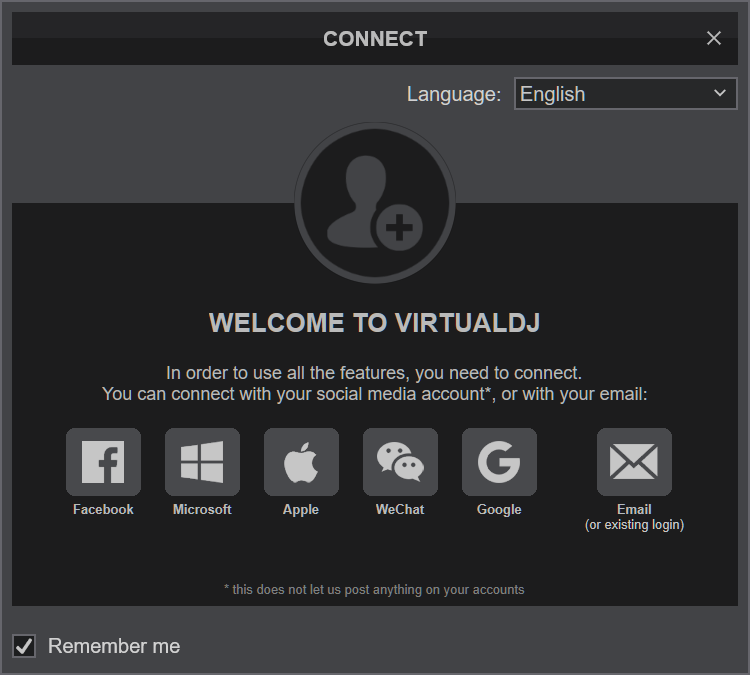
Click on the "DDJ-REV1" button for VirtualDJ to apply the predefined audio setup with the built-in sound card of the Pioneer DDJ-REV1. You can still change that from Settings->AUDIO tab.
Click to OK.
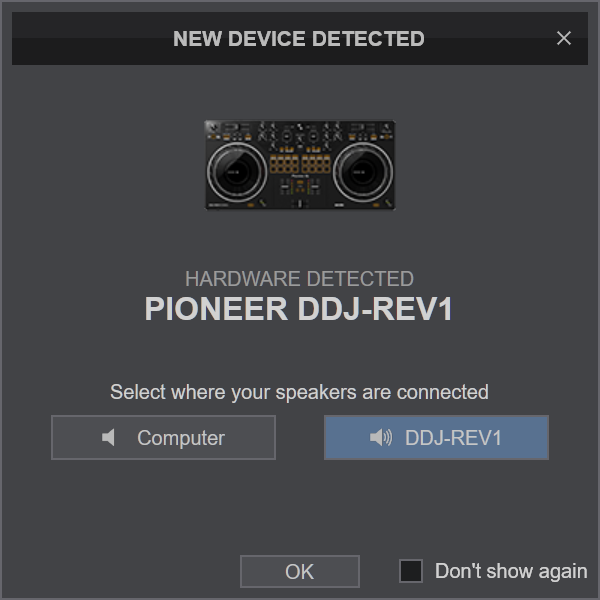
MIDI Operation
The unit should be visible in the CONTROLLERS tab of Config and the “factory default” should be available/selected from the Mappings drop-down list. The factory default Mapping offers the functions described in this Manual, however those can be adjusted to your needs via VDJ Script actions.

Find more details at VDJ Pedia
AUDIO Setup
The unit has a pre-defined Audio setup and a special button in the AUDIO tab of Config to provide that. Alternative Audio setups can be applied in the same window.
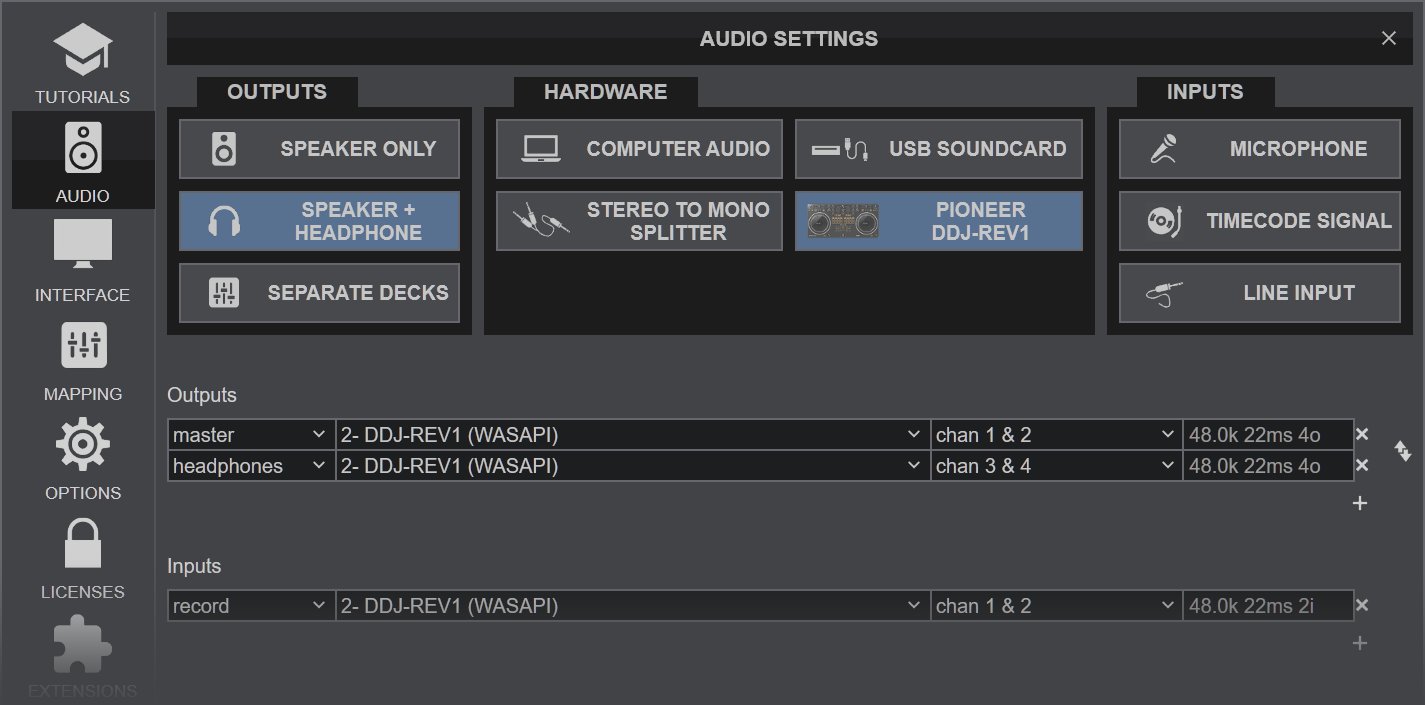
For further software settings please refer to the Manuals of VirtualDJ
LAYOUT
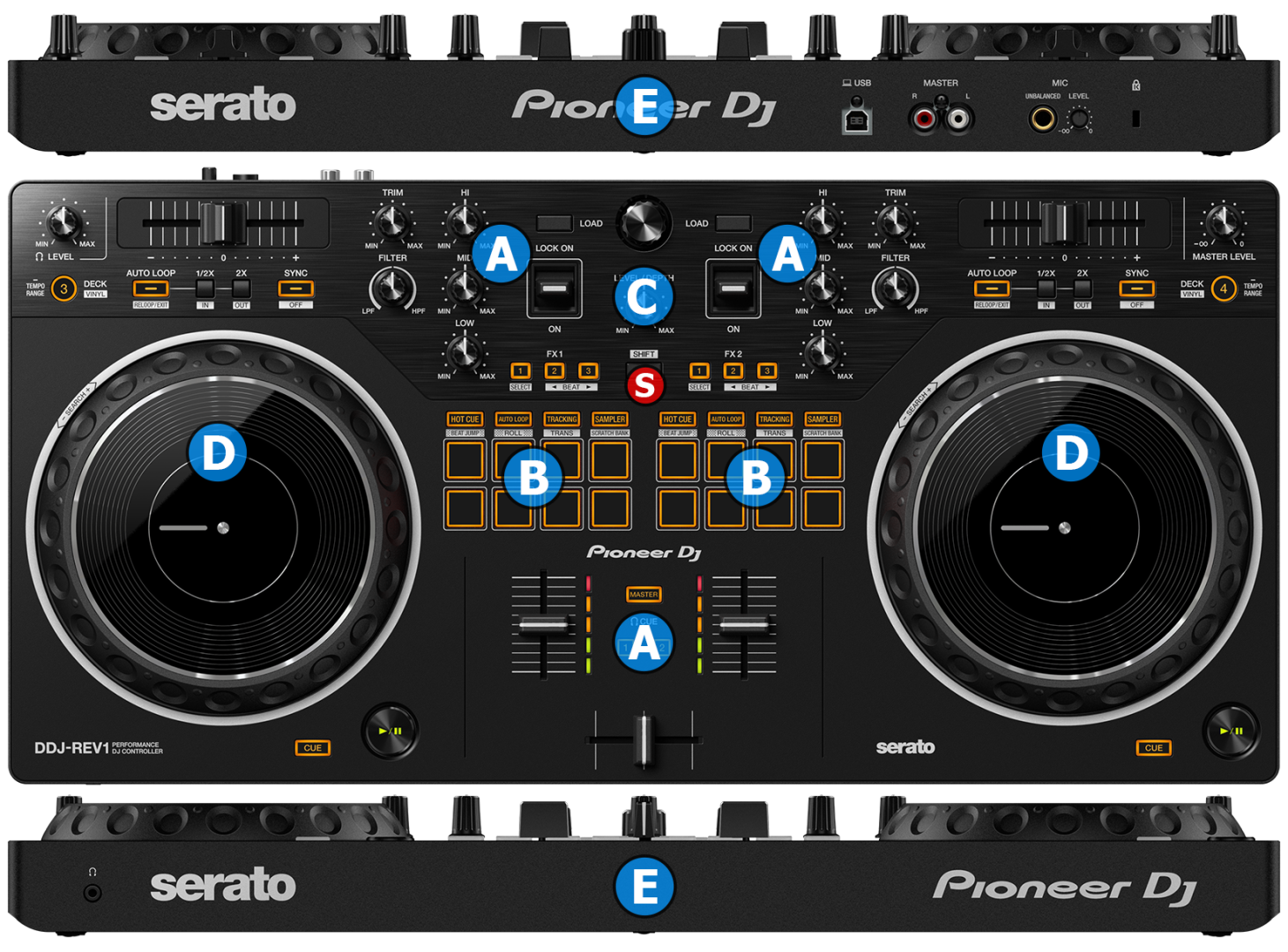
S SHIFT Press and hold this button to access secondary functions of other controls on the DDJ-REV1
The functionality of each button, knob and connection per section (as shown in the image above) will be explained in detail in the next chapters
A. Mixer Controls
B. Pads
C. Effects
D. Deck Controls
E. Front & Rear Panel
Mixer & EQ
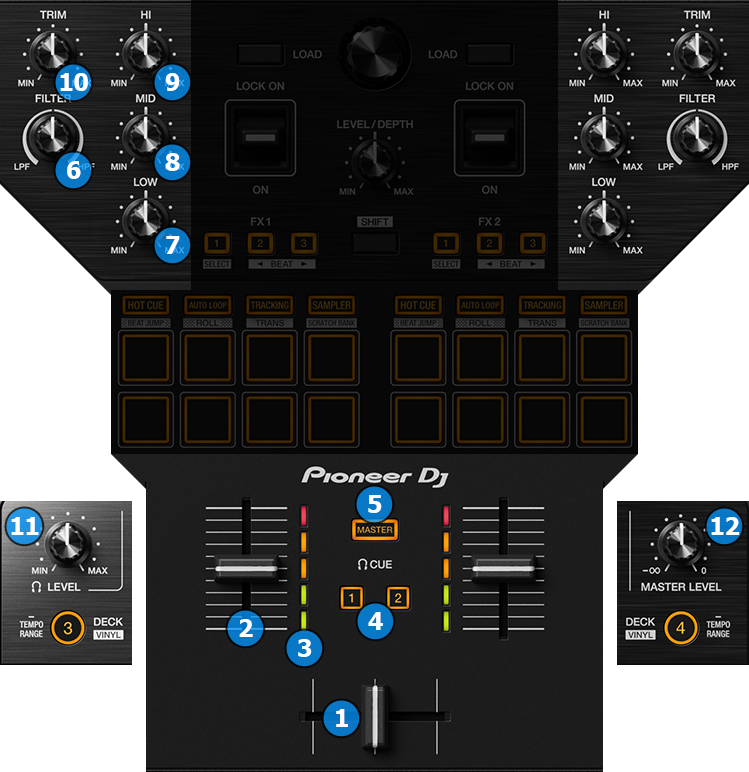
- CROSSFADER. Blends audio and video between the left and right channels.
- VOLUME. Adjust the Volume of each channel.
- VU METER. Indicate the Pre-Fader output level of the Left/Right channels.
- CUE (PFL). Press these buttons to send each channel to the Headphones Output channel
- MASTER CUE (PFL). Send the Master Output of the unit to the Headphones Output channel. Please note that in order to hear only the Master Output on your headphones you must also turn off deck PFL buttons.
- COLOR FX PARAMETER. Adjust the parameter of the selected COLOR FX for left/right channel. When in middle position, the COLOR FX has no effect on the sound. You can select a different COLOR FX from VirtualDJ GUI. Default is filter
- LOW EQ. Adjust the Low frequencies for left/right channel.
- MID EQ. Adjust the Mid frequencies for left/right channel.
- HI EQ. Adjust the High frequencies for left/right channel.
- TRIM. Adjust the Gain of left/right channel.
- HEADPHONES VOLUME. Adjust the level of the Headphones Output channel
- MASTER VOLUME. Adjust the level of the Master Output channel
TIP: You can hold down SHIFT button while operating the volume channel faders or the crossfader to automatically start/stop the decks playback (fader start)
PADS

The 8 Pads offer various functions, depending on the selected Pad mode. Each of the 4 Pad mode buttons offers 2 individual modes (hold SHIFT and then press the PAD MODE button to access the additional mode). The modes represent a page of the PADS section on the default VirtualDJ GUI.
- PAD MODE. Press any of the 4 available Pad mode buttons to set the Pads to HOTCUE, AUTO LOOP, TRACKING or SAMPLER pad pages.
Hold SHIFT button down and then press any of the 4 available Pad mode buttons to set the Pads to BEAT JUMP, LOOP ROLL, TRANS and SCRATCH BANK pad pages. - PADS. The 8 Pads offer different functionality depending on the selected mode.
TRACKING and TRANS pad pages are controlled by the device's firmware and they cannot be altered neither be assigned to a different pad page via VirtualDJ GUI. VirtualDJ GUI will show a visual representation of the pads, but clicking them on the VirtualDJ GUI will not perform any action.
For the TRACKING pad page to work properly you need to have crossfader enabled at VirtualDJ options.
For more info about Pad Pages, please see PADS
For more info about how to assign different pages on your controller, please see PAD PAGE CONTROLLER ASSIGNMENT
EFFECTS
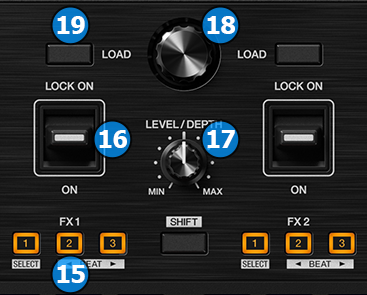
- FX SLOTS. Select one of the three available effect slots to apply on the left/right decks.
Hold down any of the three effect slot buttons and turn the "BROWSE" encoder (18) in order to select a new software effect for the given effect slot.
Hold down Shift button and press the 1st slot button to select the next available effect for the currently selected slot.
Hold down Shift button and press the 2nd slot button to decrease the Beats value for the selected effect (if available).
Hold down Shift button and press the 3rd slot button to increase the Beats value for the selected effect (if available). - FX LEVER. Apply the selected effect to the left/right deck.
- FX LEVEL. Adjust the 1st Parameter of the selected effect.
Due to firmware limitations, only one effect can be selected and applied at the time per each deck.
Browser
- BROWSE.
Turn: Scroll through content of the Folders or the Songs Lists.
Hold down SHIFT button first in order to scroll though the content of the selected Sideview List.
Push: Toggle focus between Folders and Songs List
Hold down SHIFT button first in order to toggle Browser Zoom on/off. - LOAD. Load the selected track from the Browser to the left/right Deck.
If the focus is on folders window, press this button to open/close the selected folder.
Doubleclick the button to clone the track from the opposite deck to the Left/Right Deck.
Hold down SHIFT button and then press this button to add the selected track from the Songs List to the Automix List of Sideview.
Deck Controls
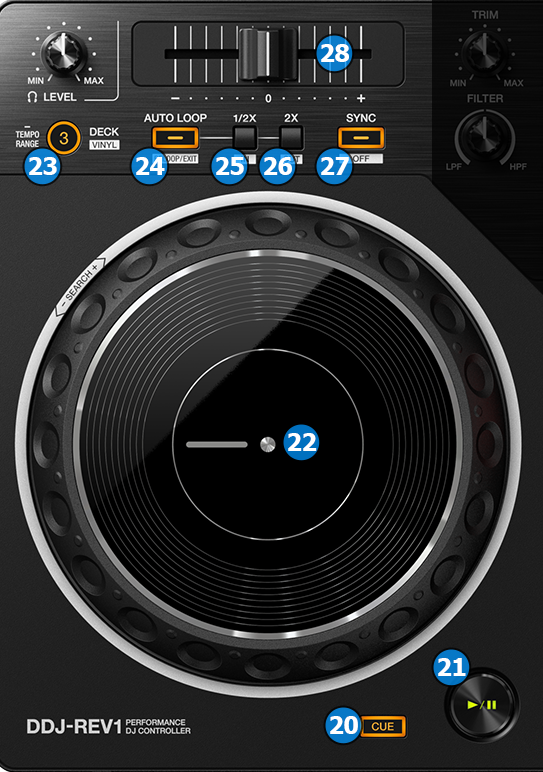
- CUE. When the Deck is paused, you can set a temporary Cue Point by moving the Platter to place the Audio Pointer at the desired location and then pressing the Cue Button. During playback, you can press the Cue Button to return the track to this Cue Point. (If you did not set a Cue Point, then it will return to the beginning of the track.). If the Deck is paused, you can press and hold the Cue Button to play the track from the Temporary Cue Point. Releasing the Cue Button will return the track to the temporary Cue Point and pause it. To continue playback without returning to the Temporary Cue Point, press and hold the Cue Button, then press and hold the Play Button, and then release both buttons.
Hold down SHIFT and then press this button to return to the beginning of the track. - PLAY/PAUSE. Plays / Pauses the track. Press and hold SHIFT and then press this button to "stutter-play" the track from the last set Cue Point.
- JOGWHEEL. Touch sensitive platter for scratching (Vinyl Mode) or bending (CD Mode).
Press and hold SHIFT and then turn the jog to seek fast inside the track (jog search) - DECK SELECT. Switch Left decks (1 and 3) and Right Decks (2 and 4).
Press and hold SHIFT and then press this button to toggle the jog between Scratch and Bend Jogwheel modes (Vinyl Mode).
Press and hold this button to cycle between the available ranges for the PITCH/TEMPO slider (8%, 16% and 50%) - AUTO BEAT LOOP. Sets an Automatic loop where it's length equals the current loop length as seen in VirtualDj GUI. Press the button again to exit the loop.
Press and hold SHIFT and then press this button to jump back and reactivate the last used loop (Reloop) - LOOP HALF. Halve the size of the current active loop, or the predefined length used by AUTO BEAT LOOP button.
Press and hold SHIFT and then press this button to set a Loop In point (for manual looping). - LOOP DOUBLE. Double the size of the current active loop, or the predefined length used by AUTO BEAT LOOP button.
Press and hold SHIFT and then press this button to set a Loop Out point and start looped playback (for manual looping). - SYNC. Press this button to automatically match the corresponding Deck's tempo with the opposite Deck's (or the Master Deck’s if using a 4 decks Skin) tempo and phase.
Press and hold SHIFT and then press this button to gradually reset the track's tempo back to it's original speed (pitch reset). - TEMPO. Controls the track's playback tempo.
Front & Rear

- HEADPHONES CONNECTOR. Connect your headphones.
- USB CONNECTOR: Use a standard USB cable to connect DDJ-REV1 with your computer.
- MASTER OUT: Master signal output connectors (RCA – Unbalanced). Use it to connect with another mixer, or consumer grade amplifier.
- MIC INPUT. Connect your MIC.
- MIC LEVEL/GAIN. Adjust the gain of the MIC input. Please note that the sound of the microphone is routed to the master by the DDJ-REV1 firmware and it's not part of the USB sound bus. This means that the sound of the microphone cannot be routed directly on VirtualDJ.
However the device offers a special "Record Loopback" channel instead that's used on the default audio setup and it allows the sound of the unit to be recorded and/or broadcasted.
